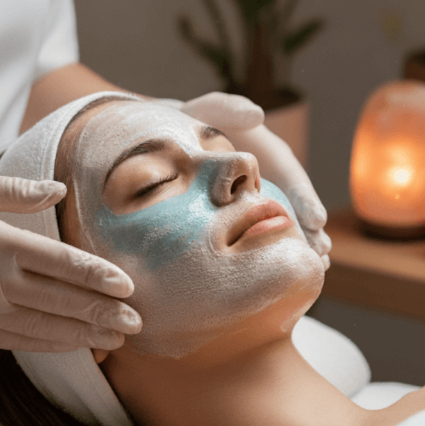Korea has become a global leader in cutting-edge skincare and medical aesthetics, offering a wide range of non-invasive treatment options for international patients seeking both beauty and wellness. One treatment that stands out for its gentle yet powerful results is LED light therapy — a safe, non-invasive solution suitable not only for beauty seekers but also for medical patients dealing with skin-related conditions or post-treatment recovery.
Whether you’re visiting Korea for medical tourism, recovering from a procedure, or managing chronic skin concerns, LED light therapy can play a crucial role in your healing and rejuvenation journey.
🌈 What Is LED Light Therapy?
LED (Light Emitting Diode) therapy is a treatment that uses low-level light energy at specific wavelengths to stimulate natural cellular processes and promote skin healing and regeneration. Unlike lasers or IPL, LED light does not cause thermal damage and involves zero downtime, making it ideal for sensitive skin or post-surgical care.
The most commonly used wavelengths include:
- Red Light (630–660 nm): Boosts collagen, accelerates wound healing, and reduces inflammation.
- Blue Light (415–450 nm): Destroys acne-causing bacteria, treats inflammatory acne, and purifies the skin.
- Near-Infrared (850–950 nm): Penetrates deeper to promote tissue repair, reduce pain, and improve circulation.
🏥 Why Medical Patients Choose LED Therapy in Korea
1. Post-Treatment Recovery Support
Many international patients come to Korea for cosmetic surgery (facelifts, rhinoplasty, liposuction) or dermatological procedures (laser treatments, microneedling, injectables). LED light therapy is often recommended as part of the post-op recovery plan to:
- Soothe inflammation and swelling
- Speed up healing of incisions or laser-treated skin
- Reduce bruising and redness
- Enhance cellular regeneration
LED light helps minimize downtime and promotes faster, healthier recovery.
2. Chronic Skin Condition Management
For patients with acne, rosacea, eczema, or psoriasis, LED therapy offers a non-medicated alternative or complementary treatment to manage symptoms without irritation. Korean dermatology clinics personalize LED light wavelengths to target:
- Acne bacteria (blue light)
- Redness and inflammation (red/yellow light)
- Skin sensitivity and dryness (near-infrared light)
3. Safe for All Skin Types and Ages
Because LED light therapy does not cause skin damage or irritation, it is safe for sensitive, mature, or compromised skin. It’s a gentle solution for patients undergoing cancer treatment, hormone therapy, or recovering from dermatological conditions.
🇰🇷 Why Korea Is a Top Destination for LED Light Therapy
Korean clinics are renowned for combining science, technology, and aesthetics. Here’s what sets them apart:
✅ Advanced Technology
Korean clinics use medical-grade LED equipment that delivers consistent and calibrated wavelengths for maximum therapeutic effect. Devices like MEDI-LED Pro, Celluma Pro, or DermaBeam are common in leading facilities.
✅ Integrated Care with Other Treatments
LED therapy is often paired with:
- Jet Peel facial for deep hydration
- Vitamin infusion (IV drips) for skin nourishment
- PRP (Platelet-Rich Plasma) therapy
- Laser resurfacing or acne scar treatments
Combining therapies enhances results and ensures holistic skin rejuvenation.
✅ English-Speaking Staff & Global Patient Support
Top clinics in Seoul offer English-speaking coordinators, medical translators, and tailored treatment plans for international patients. Pre- and post-care is explained thoroughly, making the experience stress-free and comfortable.
💡 What to Expect During a Korean LED Light Therapy Session
- Skin Assessment: A dermatologist or aesthetician evaluates your skin condition and selects the appropriate LED wavelengths.
- Cleansing & Prep: The skin is gently cleansed and prepped, often with a hydrating toner or soothing gel.
- LED Treatment: You lie comfortably under the LED light device (mask or panel) for 15–30 minutes.
- Post-Treatment Care: A calming moisturizer and sunscreen are applied. Many clinics include scalp or shoulder massage for relaxation.
The treatment is painless, relaxing, and requires no recovery time. You can go sightseeing or return to your hotel right after.
🔁 How Often Should Medical Patients Receive LED Light Therapy?
Treatment frequency depends on the condition being addressed:
- Post-surgery recovery: 2–3 times per week for 2–3 weeks
- Acne or inflammation: 1–2 sessions weekly for ongoing management
- Anti-aging or maintenance: Once every 1–2 weeks
Most clinics offer LED packages as part of broader recovery or skincare programs.
💰 Cost of LED Light Therapy in Korea
LED light therapy in Korea is highly affordable, especially when bundled with other treatments. On average:
- Single session: ₩30,000–₩80,000 (USD $20–$60)
- Package of 5–10 sessions: Discounts often available for medical tourists
High-end clinics may offer VIP packages with private treatment rooms and concierge service.
✈️ Planning Your LED Light Therapy During Your Medical Trip to Korea
Here are some tips for international patients:
- Schedule in Advance: Book appointments early if you’re visiting during peak medical tourism seasons (spring, fall).
- Ask for Recovery-Focused Packages: Some clinics offer post-liposuction, post-laser, or post-plastic surgery LED care bundles.
- Combine with Travel: LED light therapy fits easily into any schedule—it’s a perfect midday break while sightseeing.
- Bring Aftercare Products: Ask your provider for recommended serums or creams to continue healing at home.
🧴 Final Thoughts
LED light therapy in Korea is more than just a beauty trend—it’s a clinically proven, non-invasive treatment that supports healing, skin restoration, and inflammation reduction. For medical patients seeking safe, effective skin treatments during or after procedures, LED light therapy offers a comfortable, scientifically backed solution with fast, visible results.
With Korea’s advanced technology, expert care, and hospitality toward international patients, it’s no wonder LED light therapy is becoming a trusted part of many global patients’ medical journeys.




